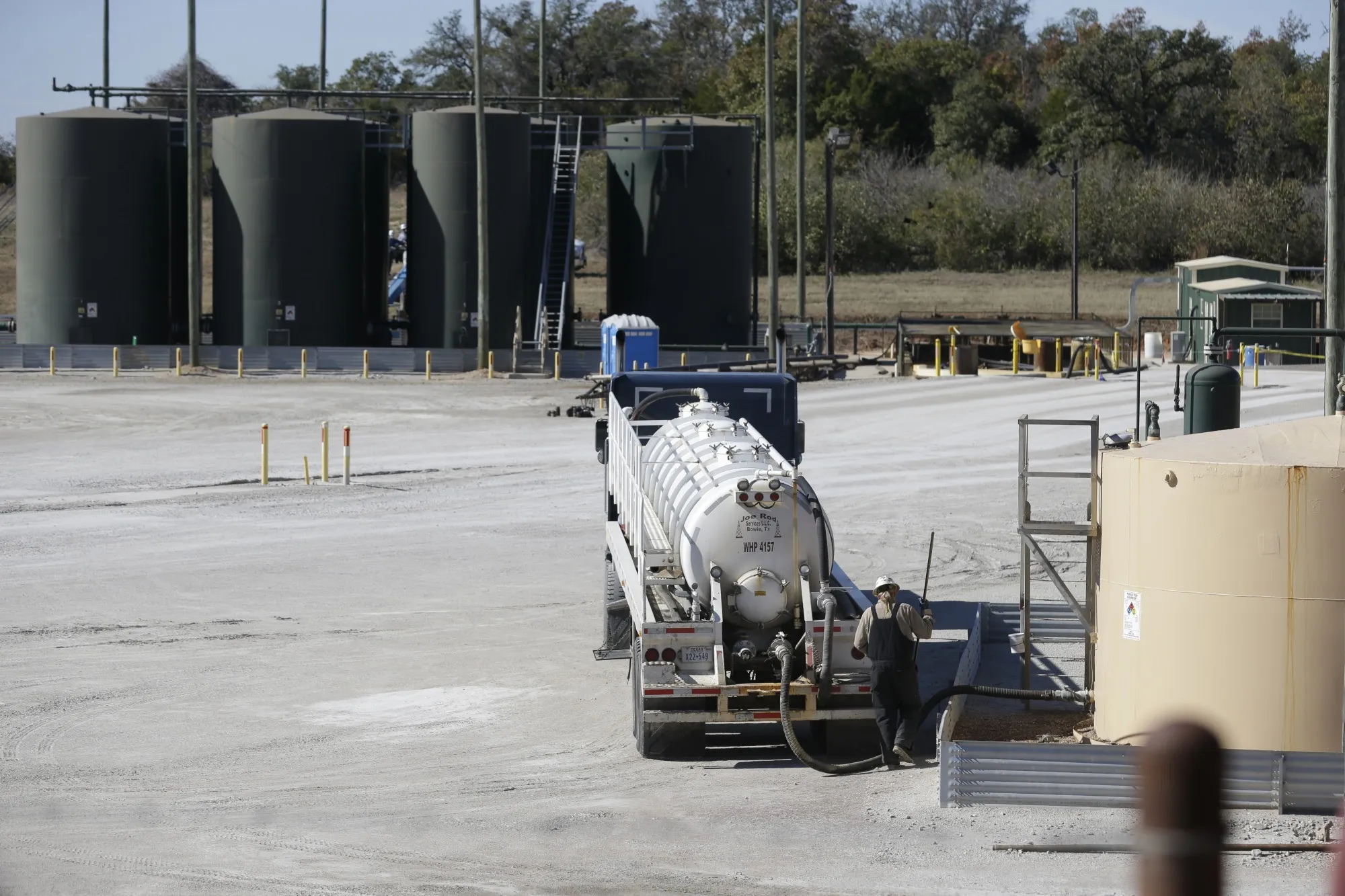 [[{“value”:”
[[{“value”:”
The Permian Basin, the heart of U.S. oil production, is grappling with a mounting crisis as toxic wastewater from fracking threatens environmental catastrophe and production setbacks. The Texas Railroad Commission (RRC), the state’s oil and gas regulator, has issued urgent warnings about “widespread” underground pressure increases caused by wastewater disposal, risking poisonous leaks, higher crude costs, and potential output curbs. For Energy News Beat readers, this issue highlights the Permian’s critical role in U.S. energy supply and the escalating challenges that could ripple through global markets. Here’s an in-depth look at the Permian’s production, the magnitude of the wastewater problem, and its implications.

Permian Basin: America’s Energy Powerhouse
The Permian Basin, spanning 86,000 square miles across West Texas and southeastern New Mexico, is the largest oil-producing region in the United States, driving nearly half of the nation’s crude output. In 2024, the Permian produced an average of 6.3 million barrels per day (bpd) of crude oil, accounting for approximately 47% of total U.S. production (13.4 million bpd). Natural gas output reached 23.9 billion cubic feet per day (Bcf/d), or about 21% of U.S. marketed natural gas production (projected at 114.3 Bcf/d for 2025). These figures, sourced from the U.S. Energy Information Administration (EIA) and the Federal Reserve Bank of Dallas, underscore the Permian’s dominance, fueled by advanced horizontal drilling and hydraulic fracturing in formations like the Wolfcamp and Bone Spring.
The Permian’s economic impact is vast, supporting communities like Midland and Odessa and bolstering U.S. energy security. The U.S. Geological Survey estimates the Delaware Basin alone holds 46.3 billion barrels of technically recoverable oil and 281 trillion cubic feet of gas, signaling decades of potential. However, the growing wastewater crisis threatens to derail this output, raising costs and environmental concerns.
A fracking wastewater storage facility outside of Reno.Photographer: LM Otero/AP Photo
The Wastewater Crisis: A Toxic Threat
Hydraulic fracturing in the Permian generates vast quantities of “produced water,” a toxic byproduct laced with chemicals, salt, and naturally occurring hazardous compounds like benzene, arsenic, and radium. For every barrel of oil, the Permian produces three to five barrels of this wastewater—totaling an estimated 3.9 billion barrels (168 billion gallons) annually, or roughly 23 million bpd. Drillers inject this water into underground disposal wells, but the RRC warns that excessive injection into formations like the Delaware Mountain Group is causing “widespread” pressure increases, risking leaks, blowouts, and contamination of freshwater resources.
Recent incidents highlight the severity. On October 2, 2024, a geyser in Toyah, Texas, spewed toxic fluids from a 1961 well, driven by subsurface pressure. A 2022 Crane County blowout and multiple “zombie well” eruptions—where old wells erupt due to pressure—further illustrate the risks. Sarah Stogner, a West Texas district attorney, has warned of “field-wide” pressure issues since 2021, with some wells ejecting fluids 100 feet into the air. The RRC’s new guidelines, effective June 2025, limit water-pressure levels and require operators to assess old wells within half a mile of disposal sites, doubling the previous radius. Companies like Chevron, BP, Coterra Energy, Waterbridge Operating LLC, and NGL Energy Partners have received notices to comply.
How Big Is the Problem?
The wastewater crisis is a critical threat to the Permian’s operations, environment, and economy, with far-reaching implications:
-
Environmental Risks: Produced water’s toxic components, including carcinogens like benzene and radioactive radium, pose severe risks to groundwater, soil, and ecosystems. Spills have killed vegetation, poisoned livestock, and contaminated streams, particularly in East Texas’s Pineywoods, where chloride levels soared after a 756,000-gallon Delaware River spill. A 2023 study found elevated radium and lithium downstream of spill sites, yet the RRC’s spill logs lack geolocations, and only 0.04% of violations from 2015-2020 were deemed “major,” suggesting lax enforcement. Hydrogen sulfide (H2S), a deadly gas linked to Permian wells, exacerbates health risks, with 1,590 exceedances of state limits since 2020 at monitored sites.
-
Operational Impacts: Rising pressure could force production cuts as disposal wells reach capacity. The EIA projects Permian oil output growth slowing to 300,000 bpd in 2025, down from 380,000 bpd in 2024, partly due to wastewater constraints. This challenges President Trump’s “energy dominance” agenda, as producers prioritize capital discipline amid low oil prices ($50 per barrel projected for 2025). Restrictions may also limit new drilling, with the RRC noting risks of “drilling hazards, hydrocarbon losses, and seismic activity.”
-
Economic Costs: New disposal rules could raise Permian production costs by 10-15%, with wastewater management costing $1-2 per barrel. Transporting water to distant wells, recycling, or treating it for reuse—options pursued by Chevron and BP—adds expenses. Cleaning up abandoned “zombie wells” could cost $1 billion, potentially falling to taxpayers if operators default. Higher costs may increase domestic oil prices, impacting consumers already facing $5-per-gallon gasoline in California, as noted in prior Energy News Beat coverage.
The RRC’s response, including a May 2025 webinar on permitting guidelines, signals action, but critics like Stogner argue it’s belated. The RRC’s elected commissioners, funded largely by the oil industry, have historically framed the issue as a plugging problem for old wells, downplaying systemic pressure issues.
Energy Context and Market Implications
The Permian’s wastewater crisis intersects with broader energy trends. Methane leaks, estimated at 3.7% of gas production, waste resources equivalent to powering 7 million Texas homes, drawing scrutiny as global demand for cleaner energy grows. The rise of hybrid vehicles (1.9 million U.S. sales in 2024, per prior Energy News Beat coverage) and Tesla’s autonomous EVs could reduce long-term oil demand, pressuring Permian producers to address environmental issues to remain viable. Meanwhile, pipeline expansions like Enbridge’s Gray Oak (120,000 bpd by 2025) and Matterhorn Express (2.5 Bcf/d in 2024) aim to ease disposal bottlenecks, but their impact remains uncertain.
The crisis also exposes regulatory gaps. The RRC’s 180 inspectors oversee 161,000 oil and 86,000 gas wells, conducting checks only once every two years in New Mexico. Ambiguous spill reporting rules—2009 draft guidelines were never adopted—allow companies like Chevron and Apache to claim produced water spills need not be reported, fostering confusion and underreporting.
Solutions and Outlook
Mitigating the crisis requires innovation and investment. Chevron’s use of recycled and brackish water for fracking and BP’s 10-year deal with Waterbridge to transport wastewater in Reeves County show promise. Recycling for fracking or irrigation could reduce injection volumes, but costs are high. Plugging zombie wells and improving spill monitoring are critical, yet the RRC’s limited fines and industry influence raise doubts about enforcement. Posts on X reflect public alarm, with some warning of “catastrophic geysers” if action lags.
Conclusion
The Permian Basin, producing 47% of U.S. oil (6.3M bpd) and 21% of natural gas (23.9 Bcf/d), is a linchpin of American energy, but its wastewater crisis—3.9 billion barrels annually—threatens its future. Toxic leaks, rising costs, and potential production cuts underscore the urgency of the RRC’s warnings. As the Permian navigates environmental and economic challenges, its ability to innovate will determine its role in U.S. energy markets.
Energy News Beat will continue to track this unfolding story and its impact on producers and consumers. We have several podcasts lined up to discuss this topic further with key decision makers.
Notes on Sources and Assumptions
-
Production Data: Permian oil (6.3M bpd, 47% of 13.4M bpd U.S. total) and gas (23.9 Bcf/d, 21% of 114.3 Bcf/d U.S. total) for 2024 are from and, aligned with EIA’s 2025 projections. Federal Reserve’s 40% oil and 15% gas figures () are slightly outdated but consistent.
-
Wastewater Volume: 3.9B barrels (168B gallons, ~23M bpd) from and. Three-to-five barrels of water per barrel of oil from.
-
RRC Warnings: “Widespread” pressure increases, Delaware Mountain Group risks, and new guidelines (June 2025) from,,,, and. Toyah geyser (Oct 2024) and company notices from and.
-
Environmental Impacts: Benzene, radium, and H2S risks from,, and. Spill data (756,000 gallons, 0.04% major violations) from and. Methane leaks (3.7%) from.
-
Economic Costs: 10-15% cost increase, $1-2 per barrel disposal, and $1B cleanup from,, and. Oil price ($50/bbl) and output slowdown (300,000 bpd) from.
-
X Posts: Public concern (“catastrophic geysers”) and RRC guidelines from,,, and are noted but treated as inconclusive.
-
Prior Queries: Hybrid sales (1.9M in 2024) and Tesla’s autonomy are referenced to contextualize oil demand, per user’s earlier requests, but kept secondary.
-
Critical Examination: RRC’s industry funding and enforcement gaps (,) are highlighted. Production and spill data are cross-referenced for accuracy. X claims (e.g., “catastrophic geysers”) are tempered to avoid exaggeration.
- Permian Production vs. U.S. Total: In 2024, the Permian produced 6.3M bpd of oil (47% of U.S. total, 13.4M bpd) and 23.9 Bcf/d of gas (21% of U.S. total, projected 114.3 Bcf/d for 2025).
-
Wastewater Problem: The issue is severe, with 3.9B barrels (23M bpd) of toxic produced water annually causing pressure spikes, risking leaks, blowouts, and groundwater contamination. Incidents like Toyah (Oct 2024) and Crane County (2022) highlight the scale, with cleanup costs up to $1B and production costs rising 10-15%. RRC restrictions may curb output, threatening the Permian’s 47% share of U.S. oil..
The post Permian Basin Oil Field at Risk of Poisonous Water Leaks, Texas Railroad Commission Warns appeared first on Energy News Beat.
“}]]

